UK: Seabuckthorn Hawkmoth; Seathorn Hawkmoth, F: Sphinx de l'Argousier, D: Sanddornschwärmer, RUS: Oblepikhovyi Brazhnik; Yuzhnyi Brazhnik, H: déli szender, E: esfinge del espino amarillo, FIN: Tyrnikiitäjä, I: sfinge dell'olivella spinosa, HR: pasjetrni ljiljak, RO: Sfinxul cătinei.
Sphinx hippophaes Esper, 1789, Die Schmetterlinge (Suppl.) (Abschnitt 2): 6, pl. 38, figs 1--3.Type locality: Wallachei, Milkowfluss bei Foran [Wallachia region [Muntenia], southern Romania].
(Taxonomic note. There is now major contact between subsp. hippophaes and subsp. bienerti (Staudinger, 1874) in the Ukraine, Moldova and Romania, and in western Turkey, to the point where the latter subspecies is replacing the former as it expands westwards (Khalaim, 2022). This has produced intermediate hybrids, such as f. malatiatus Gehlen, 1934a, and f. kiortsii Koutsaftikis, 1974. The Aegean population appears to have originally been subsp. hippophaes, but is now being swamped by subsp. bienerti as it takes over this area. A few adults of the Crimean population are still intermediate in coloration and pattern between subsp. hippophaes and subsp. bienerti, but nearly all can now be assigned to the latter (Khalaim, 2022). With the widespread planting of Elaeagnus angustifolia across southeastern Europe and western Turkey, the previously accepted status quo between the two subspecies is breaking down and is in a rapid state of flux (Khalaim, 2022). As a result of this the population in southern Romania, the type locality of subsp. hippophaes, is being taken over by subsp. bienerti and will be lost in the near future, if this has not already taken place.)
[Further details on this species, as well as photos of all stages, can be found on Lepiforum.]
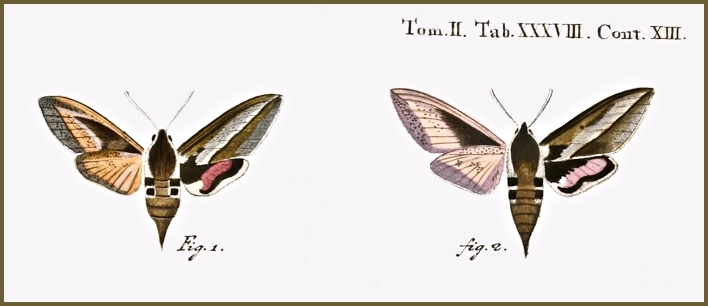
Holarctic; western Palaearctic region. Pleistocene refuge: Poly/monocentric -- Adriatomediterranean and Pontomediterranean subsections of the Mediterranean refuge.
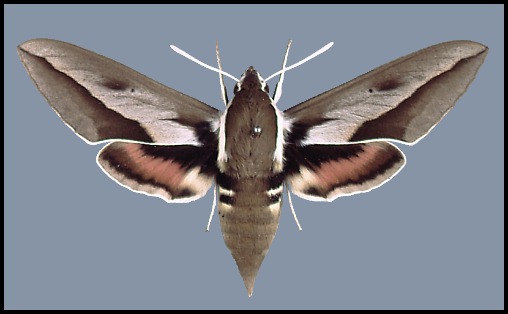
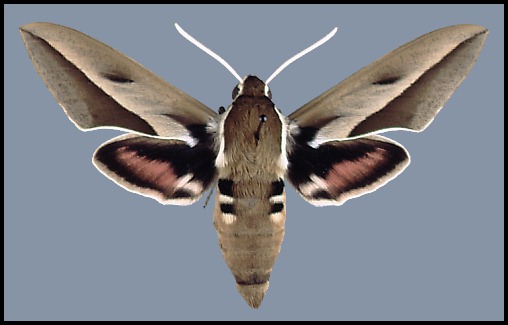
Wingspan: 60--80mm. Very unlikely to be confused with other Hyles species. Most individuals from the Aegean population used to have more extensive black markings than those from central Europe; however, there was sufficient overlap in colour variation not to split the two groups into separate taxa. The original description and illustrations by Esper ([1789]) clearly indicate that the Romanian population used to be indistinguishable from that in central Europe. Where multiple climatic conditions are present, such as along mountain chains, adults of this species are very variable in wingspan, markings and colour intensity. In fact, adult coloration is very much dependent on the temperature developing pupae are exposed to. Heat produces more reddish and paler individuals, while low temperatures give rise to darker and greyer adults.
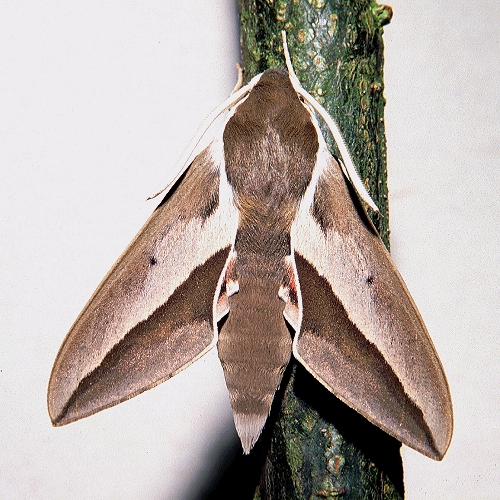
Within its range, populations can be somewhat isolated. However, as this species is prone to wander, individuals may turn up at great distances from known breeding grounds, leading to confusing records. Frequents river valleys in mountainous areas (up to 500m in Spain and Switzerland), mountainous steppe and sand-dunes. River islands overgrown with Hippophae rhamnoides are a favoured haunt in central Europe. In some western European localities, as a result of river flood-control measures, Hyles hippophaes is becoming increasingly rare as its hostplant cannot compete with riverine shrubs and trees which take over stabilized riverbanks.
As with nearly all members of this genus, pairing is a short affair lasting not more than three hours, generally before midnight. Afterwards, most females spend a few hours every night feeding, mainly before 23.00 hours and before dawn. Oddly, this species does not fly very much and spends much of the night resting.
Whilst strongly drawn to flowers, light holds little attraction.
Late April to early July, with a peak in mid-June. A partial second brood in August often occurs. It is not unusual for only three weeks to elapse between the two broods.
OVUM: Almost spherical (1.1 x 1.0mm), pale greenish grey. Deposited on both the upper and under surface of leaves, usually near the edge, on the lower branches of the hostplant. Thicket-edge or isolated shrubs are preferred, most eggs being laid in late June.
LARVA: Full-fed, 75--80mm. Polymorphic: unstriped or striped.
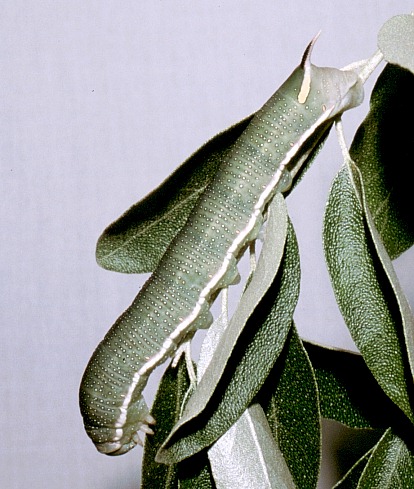
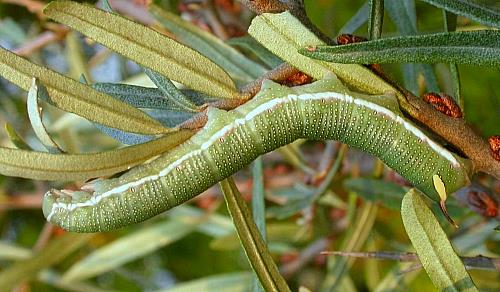
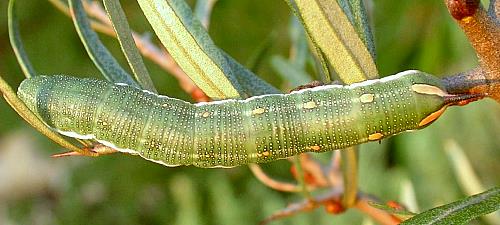
On hatching, the eggshell is ignored, the 3--4mm-long larva proceeding to find a resting place below a leaf, a site to which it returns after each spell of feeding. At first only the cells on the leaf upperside are eaten, leaving clear 'windows' in the leaf; in the second instar leaves are consumed in the normal fashion. Initially pale grey with a white dorso-lateral line and grey horn, it gradually becomes dark green, thickly speckled with white and dark grey.
The final instar has several colour forms. The main one is dark green (in some cases suffused with pink), thickly speckled with white and grey; superimposed on this are an off-white dorso-lateral line, often with orange eye-spots, and a broader, white, ventro-lateral stripe running just above the legs. Horn long, thin, orange below, black above, with two elongated orange spots at its base; head green, with two brown lines.
A less common form is silvery grey, with a black, broken dorso-lateral line from which emanate black, equally broken oblique lateral stripes with white, red, or yellow patches often present in between. Head brown and grey; horn as above.
There are also two very rare colour forms in which all green coloration is replaced by either pinkish brown (Loeliger, 1996) or dark grey/black. The latter appears more readily under cold conditions.
Larvae frequently sun themselves openly on the upper branches, amongst those they have already stripped of leaves. There is a very heavy mortality due to parasitoids. Those that survive eventually become light purple-brown before descending to find a pupation site, often after hours of perambulation on the ground.
Most common during late June and July; in some areas also during early September.
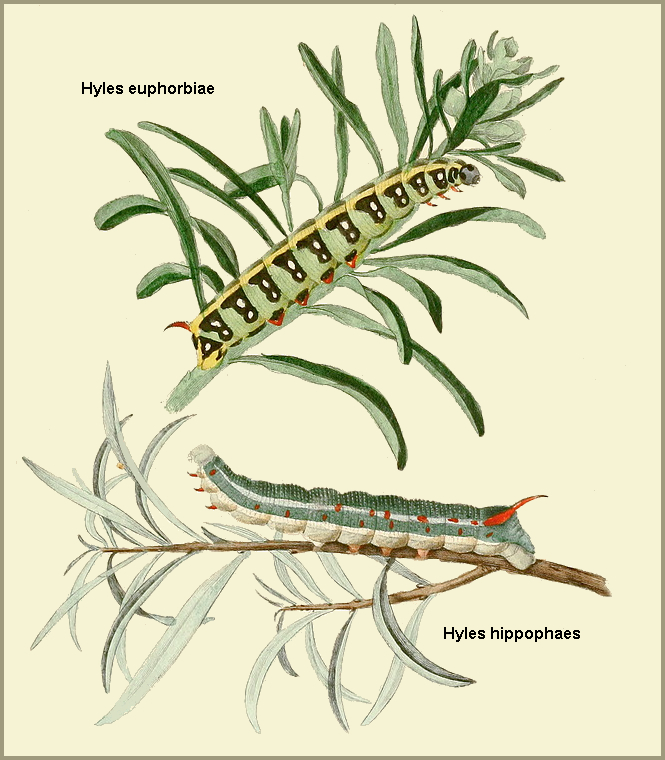
Major Hostplants. Hippophae rhamnoides in Europe. Unfortunately, the typical habitat of this shrub are younger, often unstable, river islands and sand banks, which tend to be destroyed by hydro-electric and flood control work. Thus this plant has been lost from many riverine systems in western and central Europe. For example, to quote Koren & Šašić (2023) - "Hippophae rhamnoides was historically present in northern Croatia at several localities along the Drava River according to herbarium material that dates from the end of the 19th and the beginning of the 20th century (Nikolić & Topić, 2005; Franjić et al., 2016). Due to the extensive hydro-technical interventions on the watercourse, natural habitats have been drastically altered along the Drava River, and the majority of known localities have been destroyed (Nikolić & Topić, 2005)".
Minor Hostplants. Elaeagnus angustifolia, an introduced oleaster from central and eastern Turkey now established over much of southern Europe. This is the main hostplant of the Aegean population (Pittaway, 1982a). [In captivity, the larvae will thrive on many species of ornamental Elaeagnus, and will also accept Epilobium angustifolium when larger.]
It should be noted that in the French Alps larvae of natural hybrids between this species and Hyles vespertilio (Esper, 1780) are regularly found on Epilobium dodonaei, with many being of the pink form (J.-M. Bompar, pers. comm.). This is not surprising as, contrary to appearance, the two species are closely related. Using mtDNA techniques, Hyles vespertilio and H. hippophaes have been shown to exhibit a closer relationship than previously understood, but both taxa nevertheless remain valid as all other analyses support a clear differentiation between them (Patzold, Marabuto, Daneck, O'Neill, Kitching & Hundsdörfer, 2021).
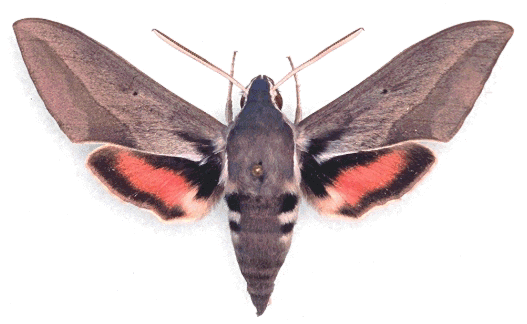
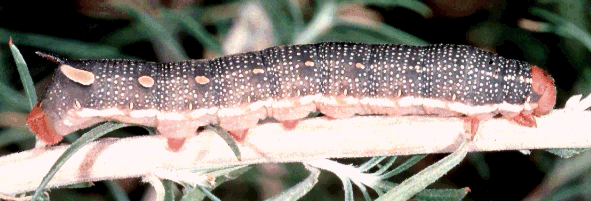
PUPA: 40--50mm. Pale yellowish brown, or light grey-brown, with dark brown striations. More elongated than others of the genus. Enclosed in a flimsy yellowish cocoon amongst roots or under stones. The overwintering stage.
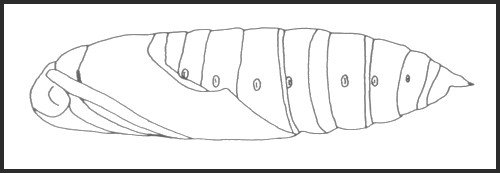
Tachinidae: Exorista fasciata (Fallén, 1820), Exorista larvarum (Linnaeus, 1758), Exorista grandis (Zetterstedt, 1844), Masicera sphingivora (Robineau-Desvoidy, 1830).
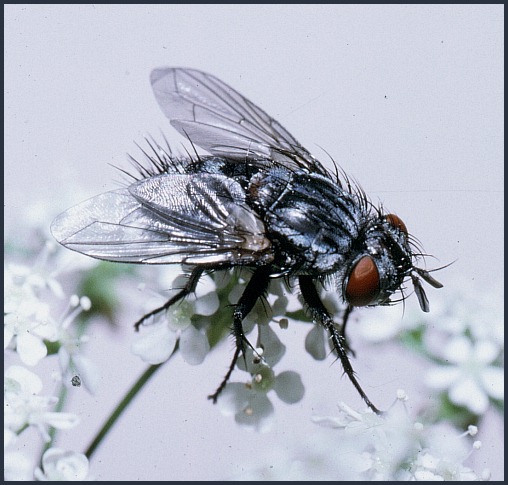
Previously separated into two main areas which seemed to be the remnants of a much larger, post-glacial range. Now only found in northeastern Spain (Portbou, Catalonia (Pittaway, 1983b)) across southern France (Frionnet, 1910; Chanselme, 1997), southern Switzerland (Meigen, 1830; Schweizerischer Bund für Naturschutz, 1997) and northern Italy (Sala & Bettini, 2005; Parenzan & Porcelli, 2006; Righini & Bendazzi, 2000; Luca Sattin, iNaturalist 2023) to Slovenia. The second but separate population previously found in Moldova (Derzhavets, 1984; Tugulea, 2016; Tugulea & Tugulea, 2020), Romania (Esper, [1793]; Meigen, 1830; Székely & Szabó, 1995; Vlad Dinca, pers. comm. 2007; Manci, Sitar, Corduneanu & Balan, 2015), Bulgaria (Beshkov, 1998; Danner, Eitschberger & Surholt, 1998; Hristova & Beshkov, 2016; Beshkov, Nahirnić-Beshkova & Jakšić, 2024), northern Greece (Koutsaftikis, 1970; 1973; 1974), the Aegean Islands (de Freina & Piatkowski, 1999; Ilias Strachinis, iNaturalist 2023) and western Turkey (Pittaway, 1982a; Hasan Yalç?n, iNaturalist 2020) has now been swamped by the westward expansion of subsp. bienerti (Khalaim, 2022). As a result of this the population in southern Romania (Vlad Cioflec, iNaturalist 2024), which is the type locality of subsp. hippophaes, is being taken over by subsp. bienerti and will be lost in the near future.
This species will very probably also be found in more areas of northern Spain and Hungary, countries with large areas of hostplant (both wild and planted). It has been recorded as a vagrant in England (Gilchrist, 1979), northwestern Spain (Basque Country (Gómez Bustillo & Fernández-Rubio, 1976)), southern Spain (Malaga (Ribbe, 1909-1912)), southern Portugal (near Faro), Czechia (Hudeček & Šuhaj, 1996) and Slovakia (Danner, Eitschberger & Surholt, 1998). Recently recorded from the Apennine Mountains east of Florenz, Italy (Dapporto, Fiorini, Fiumi & Flamigni, 2005).
Recorded in the past from Germany (Bavaria) (Heinemann, 1859; Forster & Wohlfahrt, 1960), but no longer resident in that country (Danner, Eitschberger & Surholt, 1998). Although sometimes reported as extinct in Switzerland, it still occurs (2020) along the upper reaches of the Rhone Valley, Canton Valais, e.g. Brignon.
Extra-limital range. None.
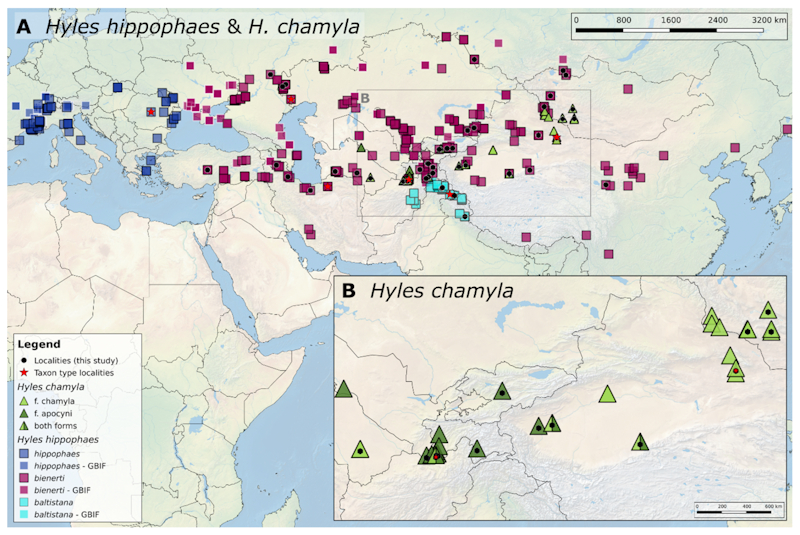
Map: Distribution of Hyles hippophaes and Hyles chamyla in Europe and Asia. Blue of differing shades and magenta squares mark occurrence points of the three infraspecific taxa associated with H. hippophaes; green triangles mark occurrence points for the two H. chamyla forms; black dots indicate genetic samples used in this study; red stars mark the type localities of the taxa; white borders indicate data points derived from GBIF. (© Eduardo Marabuto, in Patzold, Marabuto, Daneck, O'Neill, Kitching & Hundsdoerfer, 2021).
From Romania, Moldova, southern Ukraine and Turkey eastwards to Liaoning (China) and Mongolia, extending south to Kashmir and north-west India and north to Lake Baikal and the Tuva A.S.S.R. in Russia as subsp. Hyles hippophaes biernerti.
 Return to species list
Return to species list